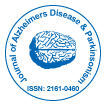Pathophysiology and Therapeutic Approaches in the Management of Alzheimer's Disease
Received: 22-Nov-2024 / Manuscript No. JADP-24-156661 / Editor assigned: 25-Nov-2024 / PreQC No. JADP-24-156661 (PQ) / Reviewed: 10-Dec-2024 / QC No. JADP-24-156661 / Revised: 17-Dec-2024 / Manuscript No. JADP-24-156661 (R) / Published Date: 24-Dec-2024 DOI: 10.4172/2161-0460.1000619
Description
Alzheimer’s disease is a progressive neurological disorder that primarily affects memory, thinking and behavior. It is the most common cause of dementia, accounting for approximately 60-80% of cases. First described by Dr. Alois Alzheimer in 1906, this debilitating condition impacts millions of people worldwide, posing significant emotional and financial challenges to families and healthcare systems.
Causes and risk factors
The exact cause of Alzheimer’s remains unclear, but experts have identified several contributing factors. Age is the most significant risk factor; the likelihood of developing the disease doubles every five years after age 65. Genetic predisposition also plays a role, particularly mutations in the APOE-ε4 gene. Other potential risk factors include cardiovascular diseases, diabetes, obesity and lifestyle factors such as smoking, poor diet and lack of physical activity. Recent studies suggest that a combination of genetic, environmental and lifestyle factors contributes to its onset and progression.
Pathophysiology
Alzheimer’s is characterized by the accumulation of two abnormal protein structures in the brain: Amyloid plaques and tau tangles. Amyloid plaques form when fragments of the beta-amyloid protein accumulate between neurons, disrupting communication. Tau tangles, on the other hand, develop inside neurons, impairing transport systems. These abnormalities lead to widespread neuronal damage and brain atrophy, particularly in the hippocampus, the region responsible for memory formation. Chronic inflammation and vascular damage further exacerbate the condition, contributing to a vicious cycle of brain deterioration.
Symptoms and progression
The disease typically begins with mild cognitive impairment, often dismissed as normal aging. Early symptoms include forgetfulness, difficulty concentrating and trouble recalling recent events. As the disease progresses, individuals experience confusion, mood swings, disorientation and difficulties with language and decision-making. Behavioral changes, such as agitation and apathy, are common. In advanced stages, patients lose the ability to carry out basic tasks, such as eating and bathing and may become entirely dependent on caregivers. Eventually, Alzheimer’s is fatal, with complications such as infections or malnutrition often contributing to death.
Diagnosis
Diagnosing Alzheimer’s involves a combination of clinical evaluations, cognitive tests and imaging studies. Tools like MRI and PET scans help detect brain changes indicative of the disease. Biomarkers in cerebrospinal fluid and blood tests are emerging as promising diagnostic tools. Neuropsychological assessments evaluate memory, problem-solving abilities and other cognitive functions. Early diagnosis is necessary, as it allows for timely intervention, better management of symptoms and participation in clinical trials that might offer new treatment options.
Treatment and management
Currently, there is no cure for Alzheimer’s. Treatments focus on managing symptoms and slowing disease progression. Medications such as cholinesterase inhibitors (e.g., donepezil) provide modest benefits in improving cognitive function and quality of life. Non-pharmacological approaches, including cognitive therapy, physical activity and social engagement, also play a vital role in patient care. Music therapy, art therapy and creating structured daily routines have shown to improve mood and reduce anxiety in patients.
Conclusion
Alzheimer’s disease represents a growing public health challenge as global populations age. While significant strides have been made in understanding and managing the disease, much work remains. Raising awareness, supporting compassionate caregiving are necessary in addressing the deep impact of this condition. Collaborative efforts between scientists, policymakers and communities can open the way for advancements that improve the lives of those affected by Alzheimer’s and their families.
Citation: Kuhl E (2024). Pathophysiology and Therapeutic Approaches in the Management of Alzheimer's Disease. J Alzheimers Dis Parkinsonism. 14: 619. DOI: 10.4172/2161-0460.1000619
Copyright: © 2024 Kuhl E. This is an open-access article distributed under the terms of the Creative Commons Attribution License, which permits unrestricted use, distribution, and reproduction in any medium, provided the original author and source are credited.
Share This Article
Recommended Journals
Open Access Journals
Article Tools
Article Usage
- Total views: 262
- [From(publication date): 0-0 - Apr 02, 2025]
- Breakdown by view type
- HTML page views: 104
- PDF downloads: 158
